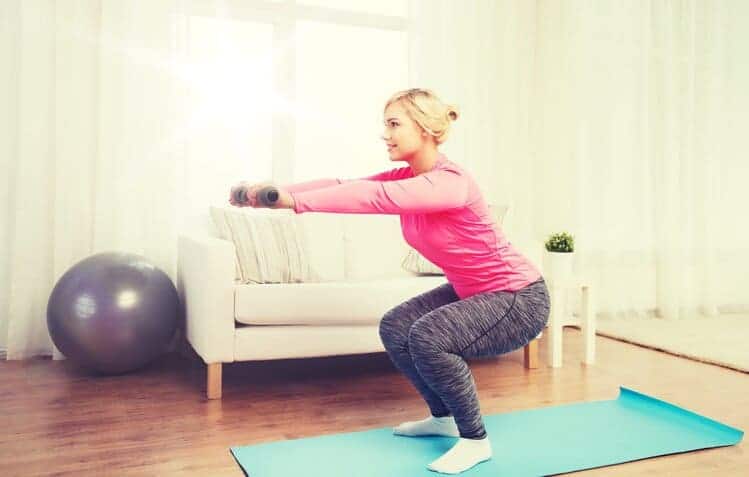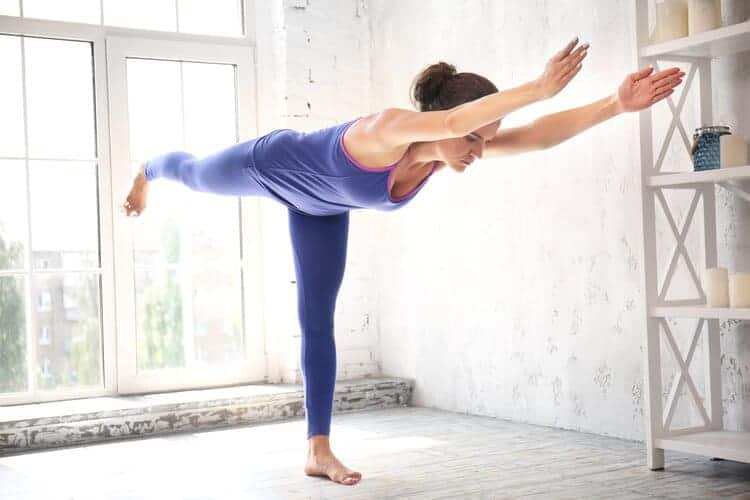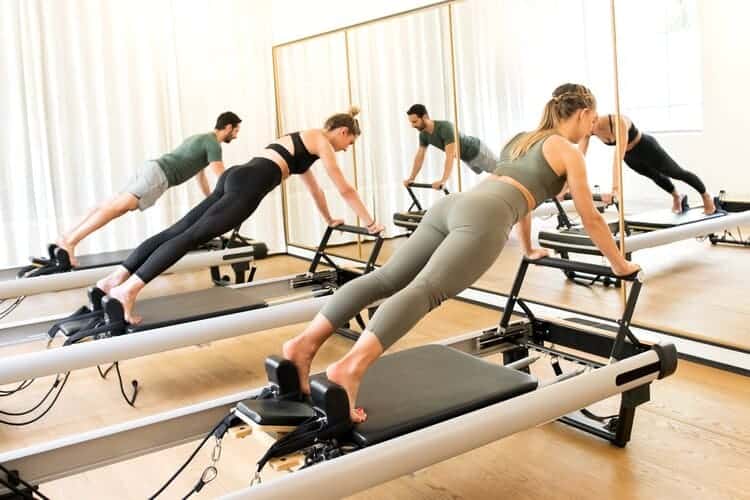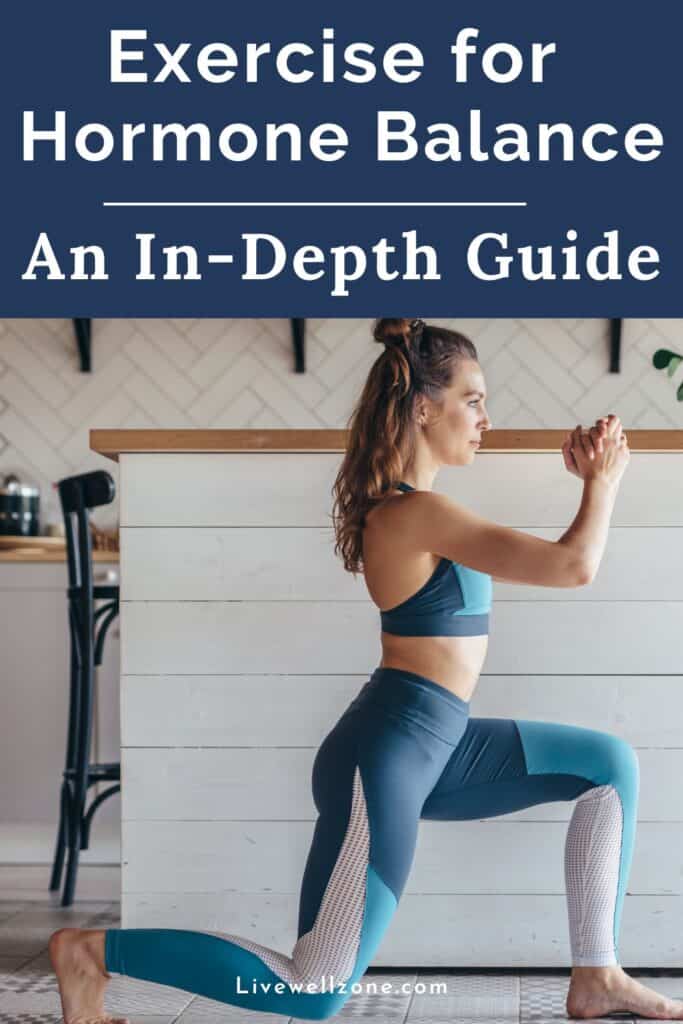
Although exercise is often looked at as a pathway to a slimmer body, science shows that it does so much more. Exercise – and really, all movement – supports the entire body at the physical, mental and emotional level.
Most of these positive benefits come from the fact that exercise has a direct effect on the endocrine (hormone) system.
So, in this article we’re going to explore:
- The tangible benefits of exercise for hormone balance.
- Tips for finding the right exercise frequency and intensity for you.
- The best exercises to do for hormonal imbalance.
DOES WORKING OUT HELP BALANCE HORMONES?
From improving mood and sleep, to boosting libido and supporting detoxification, exercise offers a wide range of benefits for any woman who’s looking to balance her hormones.
Let’s take a closer look at how this all works.
1. Improves Mood and Confidence

Hormone-induced mood swings are incredibly common. Whether due to PMS, childbearing or menopause, mood swings can pop up at any time.
Over time, the combination of hormonal and emotional fluctuations can wear down our self-esteem, making it difficult to truly enjoy and participate in our daily life.
Introducing exercise into your routine helps break this cycle, encouraging the brain to release chemicals like endorphins, dopamine and serotonin, all of which make you feel good (source).
With these mood-boosting chemicals on your side, you’ll feel a marked difference in how you feel (source). Overall, this can lead to:
- Improved body image.
- A boost in self-esteem.
- More focus and drive to achieve personal goals.
- A more positive state of mind.
2. Controls Cravings and Supports Weight Loss
Cravings aren’t something you make up in your head. They can be driven by powerful hormonal swings that alter your serotonin and even, blood sugar levels (source).
That’s why it can be incredibly hard to control cravings through willpower alone – they’re driven by deeper impulses.
Interestingly, research shows that exercise releases feel-good hormones like dopamine and serotonin, both of which tend to be low with hormonal fluctuations (source).
When it comes specifically to dopamine, it is a “reward chemical.” So, when you workout regularly, you get more “hits” of this feel-good chemical.
Over time, this can take your attention away from the unhealthy/junk food that would normally give you that feeling of satisfaction (source).
3. Supports Brain Health
Many people don’t consider the connection between brain health and their hormones. In reality, they are so strongly linked that hormone imbalances can cause serious neurological consequences.
Issues with cognitive function, memory, and brain fog are common in those struggling with hormonal imbalances. Science attributes these to abnormal levels of neurohormones, which include (source):
- Estrogen
- Progesterone
- Testosterone
- Thyroid hormones.
- DHEA
- Cortisol
So those troubling cognitive or mental health issues you’ve been experiencing? It could be caused by malfunctioning neurohormones.
When you exercise, you create a healthier environment for your brain, making it easier for your system to find its natural balance.
In fact, research has shown that regular exercise helps (source):
- Improves brain cell health.
- Promotes new blood vessel development.
- Reduces inflammation.
- Releases healthy brain chemicals.
4. Improves Sleep Quality

Sleep is one of the most important ways we reset and restore our body.
During sleep, hormones such as melatonin and growth hormone flood your system so you get deep rest and repair (source).
However, hormonal imbalances can disrupt this natural sleep cycle, forming a vicious cycle instead where:
- The hormonal imbalance disrupts sleep.
- Not enough sleep increases cortisol (a steroid hormone that regulates the stress response.)
- Too much cortisol disrupts sleep.
Working out is a proven way to interrupt this negative cycle and has been found to be as effective as sleep medication (source).
In fact, getting at least 30 minutes of daily moderate aerobic exercise helps to promote good quality sleep (source).
However, aerobic exercise typically produces brain activity that’s incompatible with winding down for sleep. So, it’s best not to do cardio close to your bedtime.
5. Supports Libido/Sexual Function
A healthy sex drive can indicate how hormones are functioning in the body.
And while a low libido has often been associated with menopause, these days younger women also experience a compromised sex drive (often because of stress and other modern-day factors).
Thankfully, exercise can support a healthy libido because it improves many factors that affect sex drive, such as (1, 2):
- Mental well-being.
- Stress levels.
- Self-confidence and esteem.
- Self image.
In addition, regular physical activity helps to boost testosterone, a hormone that is essential for a healthy sex drive in women and men.
Specifically, research shows that endurance training and resistance training both have a positive influence on testosterone levels (source).
6. Releases Stress and Anxiety
Since working out is routinely linked to weight loss and other cosmetic benefits, we don’t always acknowledge its role as a self-care tool.
But the truth is, working out is a great way to care for your inner self. It builds strength, focus and resilience, all of which are necessary for dealing with stresses of life.
In addition, physical activity is a great way to release stress and tension.
So, from this perspective, exercise is actually quite therapeutic, helping to alleviate the dark cloud of negative emotions that can sometimes linger over us.
Furthermore, research demonstrates that working out is as effective as medication for some people struggling with anxiety and depression (source).
This isn’t surprising given that exercise reduces stress hormones like cortisol and adrenaline (source).
While exercise should not be used as a replacement for professional mental help, there’s no denying the positive and long-lasting impact it has on our stress levels.
7. Improves Lymphatic Function
The lymphatic is sometimes left out of discussions about hormonal imbalance. Yet it plays a critical role because the lymphatic system is the equivalent of your home’s sewer system – it drains the gunk out.
More specifically, gunk refers to things like:
- toxins.
- viruses.
- bacteria.
- abnormal cells.
All of that gunk is carried in lymph fluid, which needs movement in order to flow.
If we don’t move regularly, all of that gunk stays in the body (and you can imagine how you’d feel if that continues long-term).
HOW MUCH EXERCISE TO BALANCE HORMONES?
As you may have guessed from our exploration so far, there’s no perfect universal equation for working out.
So here are some basic tips to keep in mind when exercising with a hormonal imbalance:
- Your workout should challenge you but should not leave you feeling depleted.
- If you get easily tired or winded during a workout, back off and try a lower intensity activity. Remember that exercise is good stress, but stress nonetheless. So, if you push yourself to do intense routines when your body isn’t ready, that good stress just turns into good old, inflammation-inducing stress.
- Be careful not to be influenced by the common misconception that you won’t lose weight without high-intensity workouts. While there are people who benefit from these workouts, they’re not the only way to have a fit and healthy body.
One of the main reasons why you should pay attention to the intensity of your workout is because of your period.
Your period can go into hiding if you exercise vigorously and/or you eat a very restrictive diet.
This condition – known as hypothalamic amenorrhea – can occur in any woman, with female athletes being one group that tends to experience it a lot (source).
So, why can too much training and a strict diet turn off your period?
Well, it’s because the body believes it’s in a “starvation state” (source).
If this condition isn’t addressed appropriately, it can create longer-term health risks, such as:
- Infertility.
- Osteoporosis (or stress fractures).
- Heart attacks (later in life).
- Breast and vaginal atrophy.
So, overall, it’s important to:
- Tailor your workouts to your circumstances.
- Explore different types of exercise (noting how your body responds).
- Vary your workouts (depending on your energy level, time allowance, etc.).
- Follow your doctor’s recommendations.
BEST EXERCISES FOR HORMONAL IMBALANCE
1. Yoga

Yoga’s flowing movements and deep stretches encourage relaxation and mental focus.
Simply by slowing down and matching individual movements with your breath, you immediately tap into your body’s relaxation response. This can counteract cortisol imbalances.
Hatha yoga and yin yoga are two types of yoga that can be particularly relaxing.
On the other hand, if you want to increase your heart rate and sweat, other more intensive forms of yoga – like ashtanga or power vinyasa – are good options.
To get started, check out the hormone-balancing yoga workout below from Yoga with Kassandra:
2. Qi-Gong and Tai-Chi
Qi-gong and tai-chi are two closely related forms of movement that focus on moving our “life force” aka qi or chi.
While Qi-gong originated about 3000 years ago in China, tai-chi has only been with us for about 800 years (source).
Although the specifics of the sequences and routines are different, both practices utilize fluid movements that act as a kind of moving meditation.
This helps reduce stress, while increasing focus and energy.
Their smooth movements also promote flexibility without putting unnecessary pressure on the joints.
For a quick sample of qi-gong, this 25-minute routine from Lee Holden is my favorite. This routine has personally helped me with so much, in particular neck pain (I no longer need regular chiropractic adjustments!).
It’s also one that I can do even on days when my energy is super low. It’s a natural recharge, led by an excellent teacher.
3. Walking and Hiking
Walking offers a low-impact form of exercise with impressive health benefits.
Not only can it help clear the mind (because of the repetitive, rhythmic movement) but it can strengthen bones, improve cardiovascular health and encourage deep breathing.
This makes it suitable for exercise newbies or as a “recovery day” activity as part of a more intense workout program.
As for hiking, it usually takes things to another level. While some hiking trails can be easy, this is generally a good option for anyone who wants a challenging workout, while taking in the sights and sounds of the great outdoors (source).
4. Dancing
Dancing is a great form of aerobic activity that can encourage concentration and free-styling creativity, bringing out your playful side.
Whatever your skill level, you’ll find a dance form that works for you.
So whether you’re learning a structured ballroom dance, a hot and sultry Latin number or a free-flowing belly dance, you can find something that matches your goals and mood.
5. Swimming
If you want quality exercise that increases your heart rate but reduces impact on your joints, swimming is ideal.
It helps to build muscle and endurance, as well as improve your cardiovascular and respiratory health.
Because swimming doesn’t strain the musculoskeletal system, it’s also something that we can do well into our golden years!
6. HIIT
HIIT – aka High Intensity Interval Training – involves short bursts of intense exercise with a short period of rest, repeated as part of a larger circuit.
It’s especially helpful for balancing hormones (when not practiced in an extreme way) and can improve:
- Insulin sensitivity.
- Fat-burning capacity.
- Reverse high cortisol levels.
- Increase HGH (Human Growth Hormone.)
And, when combined with strength training, it can help pre-menopausal and menopausal women strengthen their bones to reduce the risk of osteoporosis (source).
7. Pilates

Pilates conditions and strengthens the entire body with a particular emphasis on creating core strength.
This focus makes it useful for women who need to strengthen their midsection after childbirth (once they’ve been cleared by their physician) or women who need to improve their pelvic floor (source).
In addition, pilates’ deep muscle involvement promotes hormonal balance (source).
Overall, it’s great for the nervous system, isn’t too taxing to the body and can help you become more in-tune with yourself.
Lastly, pilates is an adaptable exercise that can be performed using the reformer machine or simply with your bodyweight and a mat.
15-MINUTE WORKOUTS TO SUPPORT HORMONAL HARMONY
So, you only have 15 minutes and you want to squeeze in a full body routine? Here are a few options to choose from:
- Bodyweight routine:
- 15-minute cardio routine:
- An energizing yoga routine:
CONCLUSION
Working out when you have a hormonal balance can be challenging, especially if you have severe fatigue.
In addition, if you have stubborn hormonal weight, you might be tempted to exercise more.
But this will only place more stress on your body and can lead to undesirable outcomes.
So, the best option is to think of exercise as a self-care tool. A tool you can lean on to relieve stress on tough days.
In addition, stay open and listen to your body. Be willing to make adjustments to your body based on the cues you get from your body.

Related Articles:
5 Tips To Balance Hormones and Start Feeling Better (in as little as a week!)

